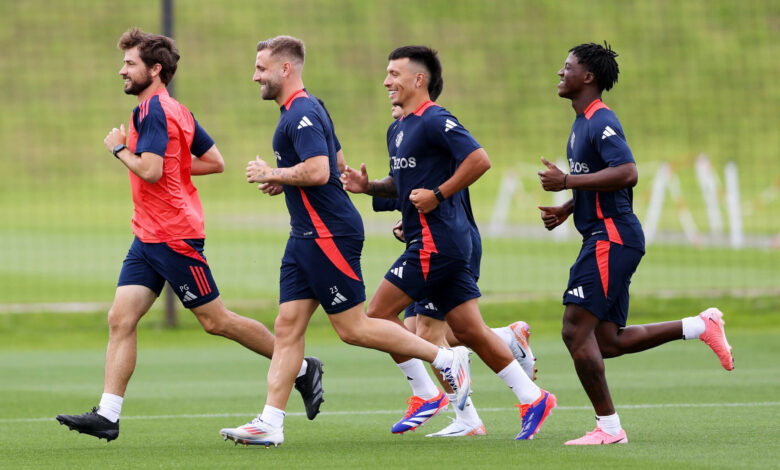How much harm do short summer breaks cause Premier League footballers?

Back they have come over the past week, one after the other, with the welcomes and embraces of team-mates captured for social media.
The international players who went furthest this summer, both in the European Championship and Copa America, have returned to their club folds and, just like that, will be asked to go again ahead of a new Premier League season beginning in nine days.
Liverpool’s well-travelled stars, including Trent Alexander-Arnold, Virgil van Dijk and Luis Diaz, reported back for testing on Sunday, before Arsenal then waved in Declan Rice and Bukayo Saka on Monday. “Back,” Manchester United succinctly posted, too, with an image of Kobbie Mainoo walking towards the club’s training complex.
Big players, one and all, but athletes who were given the briefest of summer breaks.
Just three weeks, give or take a day, were afforded to the vast majority of the 146 Premier League players who represented their country at a major tournament in June and July. And for those going deep into the event, it means the wheel barely stopped turning before the competitive football returns.
Buzzing to be back 🐝🫶#MUFC pic.twitter.com/5VBxOIVP3w
— Manchester United (@ManUtd) August 5, 2024
“It’s not just this season, it’s happened for five, six, seven years, so every time is the same,” said Pep Guardiola last month. A Community Shield date with Manchester United on Saturday comes long before many of his Manchester City squad could possibly be considered ready. “We’d like to have preparations properly, but it’s impossible,” he added.
The length of an elite footballer’s summer break has long been a concern for FIFPro, the global union that represents 65,000 professional players. They have campaigned to have a minimum four-week break, on top of a mandatory two-week in-season break, but are yet to see stakeholders show any willingness to accommodate that wish within an increasingly congested calendar.
FIFPro can point towards the misgivings of players. A 2021 survey of over 1,000 professional footballers found that 69 per cent “felt off or in-season breaks are infringed by clubs or national teams” and that 83 per cent believed regulations ought to be in place for greater protection.

Virgil van Dijk with LeBron James in London during his time off in late July (Dave Benett/ Getty Images for Gin & Juice by Dre and Snoop)
There are plenty of Premier League players who did not even enjoy three full weeks off this summer.
Luis Sinisterra was back with his Bournemouth team-mates last Thursday, 18 days after he had been part of the Colombia squad beaten by Argentina in the Copa America final, while Diogo Jota returned to the Liverpool squad in Pittsburgh 19 days after his Portugal side were knocked out of the Euros by France.
Enzo Fernandez, meanwhile, was afforded even less. The midfielder had been at the heart of controversial celebrations after his Argentina team won the Copa America last month and came back to the Chelsea camp with contrition to share after just a fortnight off.
Summer breaks and their brevity are one facet of a broader debate that has brought legal action against FIFA in recent months. Too many demands are being placed upon players without due consultation, the unions argue.
“The one thing players highlight isn’t just the number of games during the season, but the need for a proper, protected break where they know they are going to get time off,” says Ben Wright, PFA director of external affairs.
“It’s something that our members said themselves to Gianni Infantino when we arranged for him to come to Manchester to speak to them (in January 2022). They told him that it was as much a mental thing as it was physical — being able to look forward to a specific date and knowing that you would have that break for rest, holiday and time with your family, basically just to switch off from football. If you don’t have that, it just becomes absolutely relentless.”

Sinisterra had just 18 days off this summer (Dan Istitene/Getty Images)
This is not a problem for every player, of course. Any non-international Premier League footballer will have seen their season end on May 19 and, in most cases, not be asked to begin pre-season until early July. Seven weeks of rest is commonplace across the English Football League, too.
Internationals, though, do not enjoy the same repose. Friendly games were held in June’s first week in the lead-up to the Euros and Copa America, which both concluded with finals on July 14. The 2024-25 Premier League season begins 34 days later. The gap between the final of the 1984 European Championship and the curtain raiser to the English season that summer, by way of contrast, was 59 days.
Something has to give at the beginning of a season that sees UEFA expanding the Champions League and FIFA introducing a new Club World Cup, and that has been the Premier League’s mid-season break. The winter rest period, only introduced in 2018-19, has been removed from the English calendar in 2024-25 to ensure less congestion during the festive period. Previous studies have suggested that 85 per cent of top-level players were in favour of the 14-day mid-season break that has now been lost.
Next summer brings the added complication of a Club World Cup in the U.S. Any group of players going all the way to the final will not finish the 2024-25 season until July 13 and, should that be a European club, effectively leave just two or three weeks of pre-season work ahead of the 2025-26 campaign that ends with a 48-team World Cup back in the States.
“We can’t just view the (summer) break in a silo,” adds Wright. “It’s one part of the jigsaw, but it shows the need for a complete reset on how football approaches the calendar.
“If giving players a protected three-week break means the same amount of games are crammed into an even smaller window, then that’s obviously not the answer.”
Whether it’s a beach holiday or a city break, a footballer’s summer is considered a vital window for rest. FIFPro say it will “increase players’ ability to recover fully during and after a football season” and also bring the opportunity to “recover and regenerate both physically and mentally”.
There is yet to be any definitive medical research to outline what constitutes the optimal duration of a summer break. Too long and there is the challenge of starting fitness levels from the bottom with physiological strength diminished. Too short and there is insufficient time for a body to recover.

(Stuart MacFarlane/Arsenal FC via Getty Images)
“As practitioners, you’d want to see a nice steady middle ground,” says Steve Barrett, a former sports scientist with the Football Association and now vice president of sports tech company Playermaker.
“Ideally you’d want players having two weeks completely off and then two weeks of individual work leading up to pre-season again. That four weeks would be a good break, but for some players that’s too long.
“I would ask players to have two weeks of complete shut-down, let your body recover and regenerate. And if you’re going to do something, go play a different sport like tennis or volleyball. Then have two weeks build up to pre-season. You want a progressive build-up, but some clubs will monitor the players even when they’re away.”
Session one smiles 😆 pic.twitter.com/LX9b7cKbrd
— Liverpool FC (@LFC) August 5, 2024
Is three weeks sufficient time to recharge?
“There’s not really an easy answer,” he adds. “There’s not been a lot of research done into what the optimal break is. What they do say is that a change in a player’s training status will put them at a bigger risk of injuries.
“Footballers are human beings and they’re all different. Some want to switch off completely, have no contact whatsoever with their clubs. Others might be messaging you after a week of the summer asking what they can be doing. What’s good for one player, having four full weeks off, might not be good for another.
“If you have too long a break, players will come back and the first week or two of pre-season they’re struggling with aches and pains. That could be just as negative as not having a long enough break.
“Too short a break, though, can definitely be detrimental. During a long season, bodies don’t get the chance to recover properly, but you also need players to mentally switch off. When you’re mentally tired, that’s when your body can start to struggle with injuries.”
FIFPro have previously pointed towards medical evidence that would endorse a summer break of between four and six weeks, but the top end of that bracket has grown fanciful for the elite.
Former Liverpool forward Sadio Mane said in 2019 he had not enjoyed a break of more than 20 days in the seven years previous owing to international commitments to Senegal, while Julian Alvarez, heading to Atletico Madrid from Manchester City, has only just finished his 2023-24 season after representing Argentina at both the Copa America and the Olympics. One campaign has merged into another.

Guardiola is allowing Rodri, John Stones, Phil Foden and Kyle Walker to return when they’re ready (Joe Robbins/Icon Sportswire via Getty Images)
Guardiola has made a point of leaving the return dates of his four Manchester City players to reach the final of Euro 2024 — Rodri, John Stones, Phil Foden and Kyle Walker — up to each player. None were asked to join City’s pre-season tour of the U.S., an approach taken by most clubs embarking on lucrative pre-season commitments overseas.
“I said to them, come back when you are fine, when you want to come back, when you have a desire to touch the ball again,” the City boss said last week. “If you don’t feel it, stay at home because it (the season) is so long. We have to rest them. Premier League, UEFA, FIFA don’t think about them, so we have to do it as managers.”
English clubs are not technically obliged to offer anything more than three weeks of rest in summer to their players. The standard contract, approved by the PFA, says all players are entitled to five weeks of paid holiday each year and the club “shall not unreasonably refuse to permit the player to take three of such weeks consecutively”.
That legal position is in stark contrast to leading sports in the U.S. Collective bargain agreements exist in the NFL, NBA and MLB to ensure a player’s rest and off-season programmes are clearly mapped out regardless of their clubs.
NFL players are effectively on a team calendar from late July until January or February, depending on progress in the play-offs. Training camp attendance is mandatory on the countdown to a season, but it still leaves approximately three months for players to live and train where they please.
U.S. sports, though, do not have the complications of multiple stakeholders driving their own interests. Players — and their unions — hold greater powers to create schedules designed for their benefit and wellbeing.

Julian Alvarez played nine times across the Copa America and the Olympics this summer (Juan Manuel Serrano Arce/Getty Images)
“The NBA have a lot more games than us, but they’ll also have a longer break,” adds Barrett. “The fixtures are condensed. Is it better to have less-condensed fixtures, like they do in the Premier League, but have a short break? It’s probably better to have the season stretched out if it means not having condensed programmes.
“Some players will think if they have a lot of time off, they’re going to have to work harder to get back to where they need to be. Some might think they only need two weeks because then they’ll not need to do much to make sure they hit the ground running.
Back in the building ✊
Our Three Lions return to Sobha Realty Training Centre ❤️ pic.twitter.com/1cc8XjledD
— Arsenal (@Arsenal) August 4, 2024
“You’ll see a lot of players on Instagram making it known they continue training hard in the summer break and that’s becoming pretty common. There’ll also be players not wanting to miss out in some situations, such as not having the chance to impress a new manager if they take a long break when team-mates are training and playing friendlies. There a lot of dynamics involved.”
But not a lot of rest.
Foden played 69 games for club and country last season and could, in theory, play a similar number once the new season begins with the Community Shield this weekend. Three weeks off, in all likelihood, before he goes again. And again.
Summer breaks, not even guaranteed to be three weeks, illustrate one of the pinch points in a much wider debate.
“Asking clubs, competition organisers and national teams to find a single solution that balances player wellbeing, tournament dates, commercial commitments and numerous other factors is no substitute for a properly protected summer break that is respected by everyone,” says Wright.
“All we see, year on year, is the workload for the most in-demand players increasing unsustainably.”
(Top photo: Charlotte Tattersall – MUFC/Manchester United via Getty Images)




